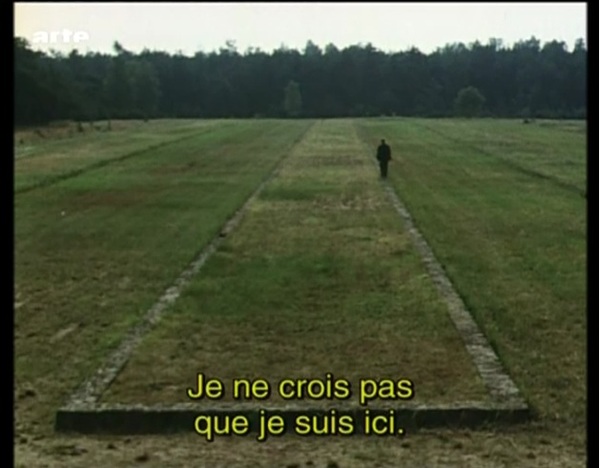Claude Lanzmann su “Shoah”, di Richard Brody
- Tag usati: claude_lanzmann, ebraismo, hitler, ii_guerra_mondiale, nazismo, shoah
- Segnala questo articolo:
Riprendiamo dal sito di The New Yorker un articolo di Richard Brody un articolo pubblicato senza indicazione di data (https://www.newyorker.com/culture/richard-brody/claude-lanzmann-on-shoah), con una nostra traduzione. Restiamo a disposizione per l’immediata rimozione se la sua presenza sul nostro sito non fosse gradita a qualcuno degli aventi diritto. I neretti sono nostri ed hanno l’unico scopo di facilitare la lettura on-line.
Il Centro culturale Gli scritti (8/7/2018)
N.B. de Gli scritti
Per la presentazione del film e del libro Shoah di C. Lanzmann, cfr. all’interno della mostra Voci dalla Shoah curata da Gli scritti ed esposta presso la Pontificia Università Gregoriana dal 22 al 25 settembre 1997.

Circa vent'anni fa, un amico in Francia mi mandò un libro che era stato appena lì pubblicato, "Au Sujet de Shoah" ("Sulla Shoah"), una raccolta di saggi sul film […] sulle interviste e gli scritti del regista, Claude Lanzmann. Mi piacerebbe condividere un paio di brevi passaggi che sono straordinariamente illuminanti. In un'intervista originariamente apparso sulla Nouvelle Revue de Psychanalyse, François Gantheret gli domandò sull'interesse di Lanzmann per i "dettagli" e persino le "minuzie" dell'Olocausto (che l'intervistatore paragona ai metodi della psicoanalisi). Lanzmann rispose:
A volte, quando mi volgo indietro, mi chiedo: qual è il punto in questione? Tutto è noto, il risultato finale è noto: sei milioni sono stati uccisi. Quindi, perché i dettagli? A volte, non capisco nemmeno il metodo che ho seguito: per quale motivo l’ho fatto? Quando arrivai ai non-luoghi della memoria, andai a trovare un vecchio capotreno alla stazione di Sobibor e gli chiesi: "Mostrami. Mostrami dove iniziava il campo di concentramento”. Disse: "Bene, ti mostrerò il punto esatto". Abbiamo fatto qualche passo e lui ha detto: "Guarda. Qui, c'era un picchetto di recinzione. Ecco, qui ce n'era un altro”. E mi vidi scavalcare quella linea e dire a me stesso: "Ecco, ora sono dentro al campo". Camminai poi tre metri indietro: "Eccomi, qui sono fuori dal campo. Da questa parte c'è vita. Dall'altra parte, la morte". E quel tipo di estrema urgenza che ho avuto, di riviverlo, di attraversare quella linea immaginaria, è qualcosa che, anche oggi, rimane sconosciuto anche a me stesso.
Nel mio Critic's Notebook sul film nella rivista di questa settimana, sottolineo il fatto che il film non presenta fatti ma esperienza, attraverso il portato della testimonianza. C'è una parola che non ho usato e che vorrei utilizzare ora - e Lanzmann la fornisce, in un altro brano che è nel libro: la trasmissione.
"Perché solo l'atto di trasmissione mi interessa, e nessuna intelligibilità - cioè, nessuna vera conoscenza – è possibile senza una trasmissione preesistente. La trasmissione è la conoscenza stessa".
La straordinaria radicalità del film - morale, estetica e formale - sta nella messa in scena della trasmissione e nella sua rappresentazione. Trasmette e mostra come avviene la trasmissione, o piuttosto come, per mezzo di atti di volontà, intelligenza, sensibilità e moralità, tale trasmissione diviene possibile.
Claude Lanzmann on “Shoah”, Richard Brody
About twenty years ago, a friend in France sent me a book that had just been published there, “Au Sujet de ‘Shoah’ ” (“On the Subject of ‘Shoah’ ”), a collection of essays about the film (which re-opens at Lincoln Plaza Cinemas today, and goes to IFC Center on December 24th) and of interviews with and writings by the filmmaker, Claude Lanzmann. I’d like to share a couple of brief passages that are extraordinarily enlightening. In an interview that originally appeared in the Nouvelle Revue de Psychanalyse, François Gantheret asked about Lanzmann’s interest in “details” and even “minutiae” of the Holocaust (which the interviewer likens to the methods of psychoanalysis). Lanzmann answered:
Sometimes, when I take a step back, I myself wonder: what’s the point? Everything is known, the final result is known: six million were killed. So, why the details? At times, I don’t even understand my method: what made me do it? When I arrived at the non-places of memory, and I went to find an old train conductor at the Sobibor station, and asked him: “Show me. Show me where the camp began.” He said, “Well, I’ll show you.” We walked a few steps and he said, “Look. Here, there was a picket. Here, there was another one.” And I see myself stepping over that line and saying to myself, “Here, I’m inside the camp.” And I walked ten feet back: “Here, I’m outside the camp. On this side is life. On the other side, death.” And that kind of extreme urgency that I had, to relive this, to cross that imaginary line, is something that, even today, remains unknown even to myself.
In my Critic’s Notebook about the film in the magazine this week, I emphasize the fact that the movie presents not facts but experience, by means of the bearing of witness. There’s a word I didn’t use and that I wish I had—and Lanzmann provides it, in another piece from the same journal that’s in the book: transmission. “Because only the act of transmission matters, and no intelligibility—that is, no true knowledge—pre-exists transmission. Transmission is knowledge itself.” The film’s extraordinary radicality—moral, aesthetic, and formal—is in the enactment of transmission along with the depiction of it. It transmits, and it shows how transmission happens—or, rather, how, by acts of will, intelligence, sensibility, and morality, it is achieved.



